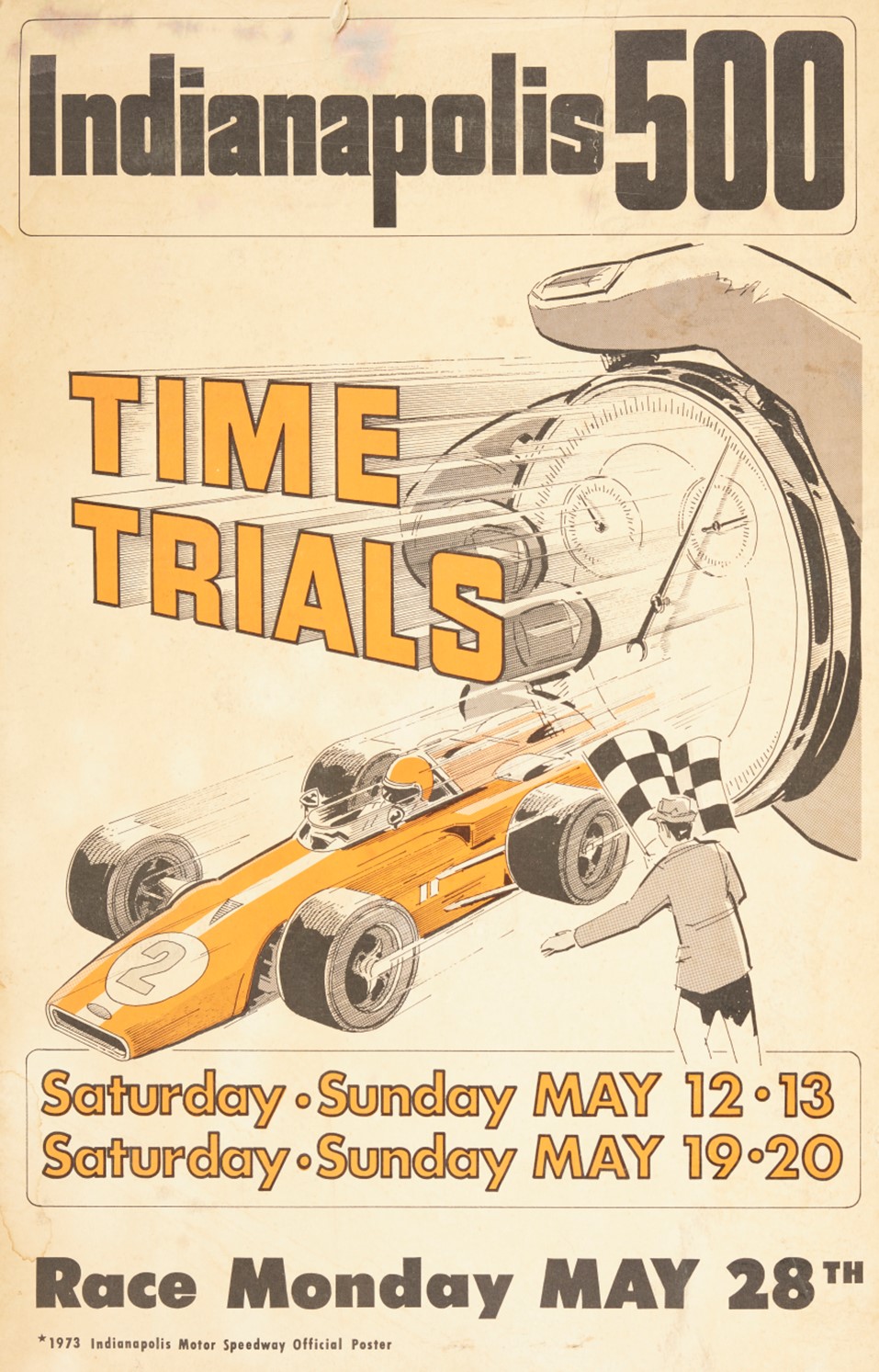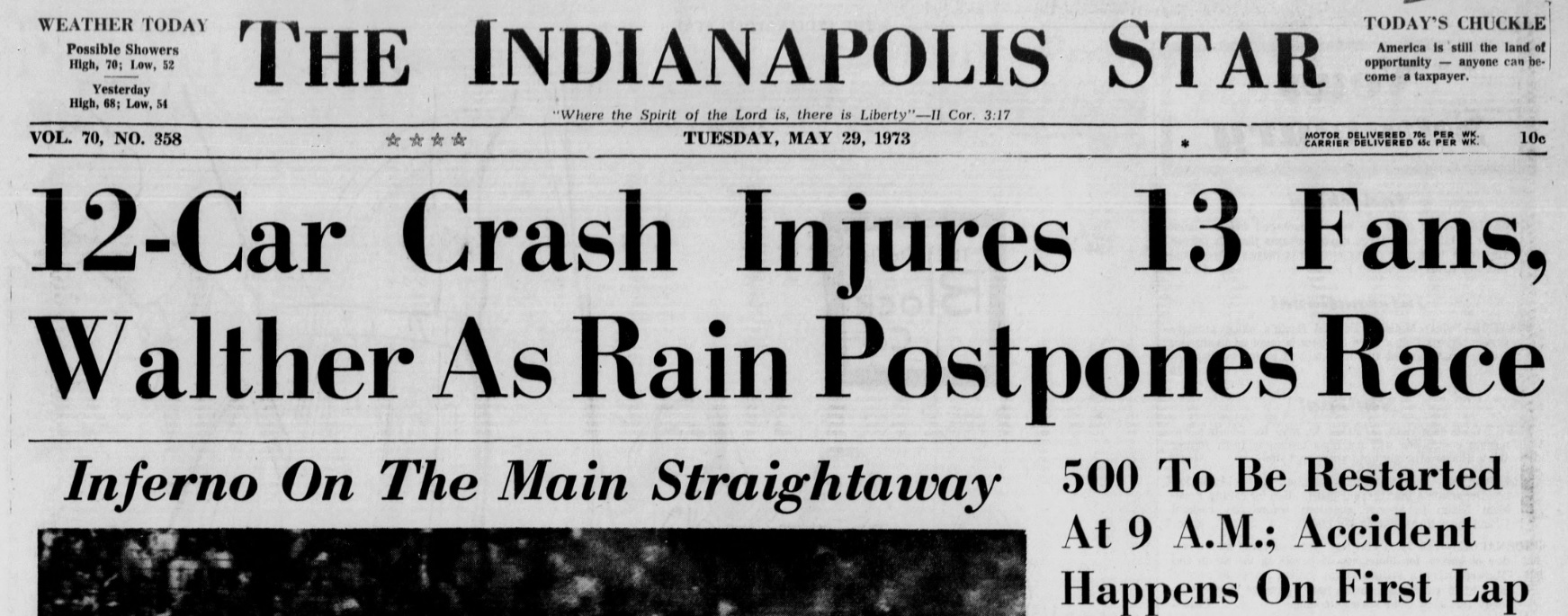Since the inaugural race in 1911, the Indianapolis 500 has provided racing fans with fast thrills in the month of May. Some years have provided more drama than others and 1973 was certainly such a year.

Poster advertising the 1973 time trials. Medium Broadsides Collection, Rare Books and Manuscripts Division.
1973 was the 57th running of the race and going into it, fans were excited to see cars possibly reach 200 mph speeds for the first time ever. Qualifications began on Saturday, but before they could even start, driver Art Pollard crashed on a practice run and would eventually die from his injuries. The time trials continued with Johnny Rutherford posting the fastest time at 199.071 mph, tantalizingly close to the coveted 200 mph, but still short.
The race was scheduled for Monday, May 28. After an initial four-hour rain delay, the race officially started but things went horribly wrong on the very first lap. Caused in part by a car moving extremely slow due to a mechanical failure, a 12-car crash put an immediate halt to the race. A massive fireball from the wreckage of driver Salt Walther’s car reached spectators in the stands and several were rushed to local hospitals with serious burns. While he survived the wreck, Walther would have to undergo a very lengthy recovery and, in the process, became addicted to pain medication, a condition he struggled with for the rest of his life until dying from an overdose in 2012. Perhaps fortuitously, another torrential rainstorm began shortly after the wreck and the race needed to be postponed to the next day.
Racing conditions did not improve the following day. Despite over 200,000 fans showing up for the second attempt at the race, another postponement was announced. This was the first time in the race’s history that a race had to be postponed two days in a row. Spirits were low among drivers, crews and fans with some hoping the race would be completely cancelled.

Sheltering from the rain on Pit Row. Picture from the official yearbook for the 1973 Indianapolis 500 (ISLI 796.7 I388i 1973).
The third and final attempt at running the race occurred on Wednesday, May 30. The weather continued to threaten rain but the sun came out briefly and dried the track enough to start the race. Racing resumed and was a typical Indianapolis 500 for over 50 laps until a wreck on the 57th lap trapped driver “Swede” Savage in yet another huge fireball. Pit crew members from various teams ran on foot towards the accident and one of them, Armando Teran, was accidentally killed by an emergency vehicle which was also speeding towards the wreck. While initially surviving the inferno, Savage would ultimately succumb to his injuries several weeks later.
Spectators near the wreck were understandably traumatized. They had to watch both Savage moving around in the remains of his car, desperately trying to get out while completely engulfed in flames, followed by witnessing the violent death of Armando Teran. Several fans, including women from the 500 Festival court, fainted.
Once the accident had been cleared away, the race trudged on but when rain began to fall yet again, a final red flag was flown at lap 133, 67 laps short of the normal 200. The leader, Gordon Johncock, was named the winner and the 57th running of the Indy 500 mercifully came to end. Only 11 of the original lineup of 33 cars managed to finish the race.
The troubles of the 1973 race and the collective anger of drivers and teams resulted in the creation of several safety measures. Due to the numerous large fires caused by crashes, cars were no longer allowed to carry so much fuel and it was recommended that fuel tanks be on the left side of the car, to avoid damage and explosions when hitting walls. Another change required pit crew members to remain at their posts in order to keep out of the way of safety crews.
Ultimately, it took the 1973 Indy 500 three whole days to complete a mere 332 miles making it both the longest and shortest race at the time. Even though Rutherford came very close to reaching 200mph during qualifications, race fans would have to wait four more years to witness a driver achieve that particular feat, which Tom Sneva did in 1977.
This blog post was written by Jocelyn Lewis, Catalog Division supervisor, Indiana State Library. For more information, contact the Indiana State Library at 317-232-3678 or “Ask-A-Librarian.”




